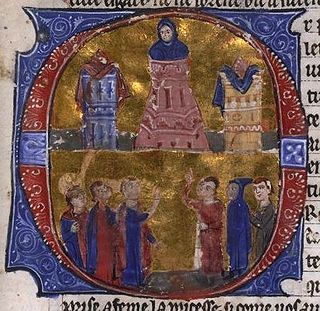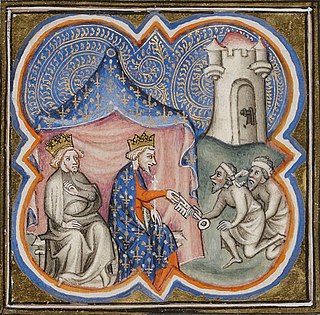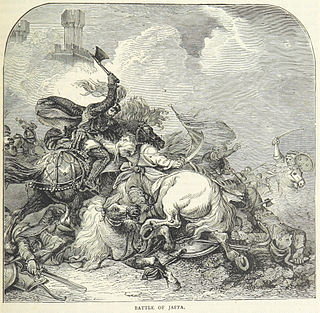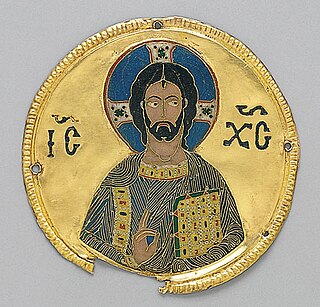Related Research Articles

Richard I was King of England from 1189 until his death in 1199. He also ruled as Duke of Normandy, Aquitaine and Gascony; Lord of Cyprus; Count of Poitiers, Anjou, Maine, and Nantes; and was overlord of Brittany at various times during the same period. He was the third of five sons of Henry II of England and Eleanor of Aquitaine and seemed unlikely to become king, but his two elder brothers predeceased their father. Richard is known as Richard Cœur de Lion or Richard the Lionheart because of his reputation as a great military leader and warrior. The troubadour Bertran de Born also called him Richard Oc-e-Non, possibly from a reputation for terseness.

Salah ad-Din Yusuf ibn Ayyub, commonly known as Saladin, was the founder of the Ayyubid dynasty. Hailing from a Kurdish family, he was the first sultan of both Egypt and Syria. An important figure of the Third Crusade, he spearheaded the Muslim military effort against the Crusader states in the Levant. At the height of his power, the Ayyubid realm spanned Egypt, Syria, Upper Mesopotamia, the Hejaz, Yemen, and Nubia.
The 1190s was a decade of the Julian Calendar which began on January 1, 1190, and ended on December 31, 1199.

Year 1191 (MCXCI) was a common year starting on Tuesday of the Julian calendar.

The Third Crusade (1189–1192) was an attempt led by three European monarchs of Western Christianity to reconquer the Holy Land following the capture of Jerusalem by the Ayyubid sultan Saladin in 1187. For this reason, the Third Crusade is also known as the Kings' Crusade.

Raynald of Châtillon, also known as Reynald or Reginald, was a knight of French origin who became Prince of Antioch from 1153 to 1160 or 1161 and Lord of Oultrejordain from 1175 until his death. The second son of a French noble family, he joined the Second Crusade in 1147, and settled in the Kingdom of Jerusalem as a mercenary. Six years later, he married Constance, Princess of Antioch, in spite of her subjects' opposition.

The Battle of Hattin took place on 4 July 1187, between the Crusader states of the Levant and the forces of the Ayyubid sultan Saladin. It is also known as the Battle of the Horns of Hattin, due to the shape of the nearby extinct volcano of that name.

The Ayyubid dynasty, also known as the Ayyubid Sultanate, was the founding dynasty of the medieval Sultanate of Egypt established by Saladin in 1171, following his abolition of the Fatimid Caliphate of Egypt. A Sunni Muslim of Kurdish origin, Saladin had originally served Nur ad-Din of Syria, leading Nur ad-Din's army in battle against the Crusaders in Fatimid Egypt, where he was made Vizier. Following Nur ad-Din's death, Saladin was proclaimed as the first Sultan of Egypt by the Abbasid Caliphate, and rapidly expanded the new sultanate beyond the frontiers of Egypt to encompass most of the Levant, in addition to Hijaz, Yemen, northern Nubia, Tarabulus, Cyrenaica, southern Anatolia, and northern Iraq, the homeland of his Kurdish family. By virtue of his sultanate including Hijaz, the location of the Islamic holy cities of Mecca and Medina, he was the first ruler to be hailed as the Custodian of the Two Holy Mosques, a title that would be held by all subsequent Sultans of Egypt until the Ottoman conquest of 1517. Saladin's military campaigns in the first decade of his rule, aimed at uniting the various Arab and Muslim states in the region against the Crusaders, set the general borders and sphere of influence of the Sultanate of Egypt for the almost three and a half centuries of its existence. Most of the Crusader states, including the Kingdom of Jerusalem, fell to Saladin after his victory at the Battle of Hattin in 1187. However, the Crusaders reconquered the coast of Palestine in the 1190s.

The Battle of Arsuf took place on 7 September 1191, as part of the Third Crusade. It saw a multi-national force of Crusaders, led by Richard I of England, defeat a significantly larger army of the Ayyubid Sultanate, led by Saladin.

The siege of Acre was the first significant counterattack by Guy of Jerusalem against Saladin, leader of the Muslims in Syria and Egypt. This pivotal siege formed part of what later became known as the Third Crusade. The siege lasted from August 1189 until July 1191, in which time the city's coastal position meant the attacking Latin force were unable to fully invest the city and Saladin was unable to fully relieve it with both sides receiving supplies and resources by sea. Finally, it was a key victory for the Crusaders and a serious setback for Saladin's ambition to destroy the Crusader states.
The Saladin tithe, or the Aid of 1188, was a tax levied in England and, to some extent, France, in 1188, in response to the capture of Jerusalem by Saladin in 1187.

The siege of Jerusalem lasted from 20 September to 2 October 1187, when Balian of Ibelin surrendered the city to Saladin. Earlier that summer, Saladin had defeated the kingdom's army and conquered several cities. Balian was charged with organizing a defense. The city was full of refugees but had few soldiers. Despite this fact the defenders managed to repulse several attempts by Saladin's army to take the city by storm. Balian bargained with Saladin to buy safe passage for many, and the city was peacefully surrendered with limited bloodshed. Though Jerusalem fell, it was not the end of the Kingdom of Jerusalem, as the capital shifted first to Tyre and later to Acre after the Third Crusade. Latin Christians responded in 1189 by launching the Third Crusade led by Richard the Lionheart, Philip Augustus, and Frederick Barbarossa separately. In Jerusalem, Saladin restored Muslim holy sites and generally showed tolerance towards Christians; he allowed Orthodox and Eastern Christian pilgrims to visit the holy sites freely—though Frankish pilgrims were required to pay a fee for entry. The control of Christian affairs in the city was handed over to the Ecumenical Patriarch of Constantinople.

The Battle of Jaffa took place during the Crusades, as one of a series of campaigns between the army of Sultan Saladin and the Crusader forces led by King Richard I of England. It was the final battle of the Third Crusade, after which Saladin and King Richard were able to negotiate a truce. Although the Crusaders did not regain possession of Jerusalem, Christian pilgrims were permitted entry into the city, and the Crusaders were able to retain control of a sizable strip of land stretching from Beirut to Jaffa.

Saladin the Victorious, also known as Saladin and the Great Crusades, is a 1963 Egyptian epic film directed by Youssef Chahine. It is written by Yusuf Sibai, based on the novel by Naguib Mahfouz. The film features an ensemble cast, It stars Ahmed Mazhar as Saladin, Salah Zulfikar as Issa El Awwam, Nadia Lutfi as Louisa de Lusignan, Omar El-Hariri, Mahmoud El-Meliguy, Leila Fawzi, Hamdi Gheiss, Ahmed Luxor, Hussein Riad, Laila Taher and Zaki Toleimat.

The 1889 Apia cyclone was a tropical cyclone in the South Pacific Ocean, which swept across Apia, Samoa on March 15, 1889, during the Samoan crisis. The effect on shipping in the harbour was devastating, largely because of what has been described as "an error of judgement that will forever remain a paradox in human psychology".

Richard I of England has been depicted many times in romantic fiction and popular culture.

Christianity in the 12th century was marked by scholastic development and monastic reforms in the western church and a continuation of the Crusades, namely with the Second Crusade in the Holy Land.

The History of Jerusalem during the Kingdom of Jerusalem began with the siege of the city in 1099 as part of the First Crusade. This resulted in Jerusalem being conquered by Christian forces, after it had been under Muslim rule for nearly 450 years. It became the capital of the Latin Kingdom of Jerusalem, until it was again conquered by the Ayyubids under Saladin in 1187. For the next forty years, a series of Christian campaigns, including the Third and Fifth Crusades, attempted in vain to retake the city, until Holy Roman Emperor Frederick II led the Sixth Crusade and successfully negotiated its return in 1229.

The Book of Saladin is an historical novel by Pakistani-born British writer Tariq Ali, first published in 1998. The second in Ali’s Islam Quintet, the narrative purports to be the memoir of the 12th-century Muslim leader Saladin, or Salah al-Din, who famously captured Jerusalem from the Crusaders in 1187.
References
- ↑ Regan, Geoffrey (4 August 2003). "War technology cannot always trump human error". USA Today.
- ↑ Regan, Geoffrey (1 December 2001). "Time Bandit". History Today. Vol. 51. Archived from the original on 23 August 2011. Retrieved 6 September 2012.
... explains how the experience of boredom in the classroom set him off into a career as inspirational teacher, writer and broadcaster
- ↑ "Geoffrey Regan website". 2000. Archived from the original on 9 December 2000. Retrieved 19 January 2017.
- ↑ "Lionhearts by Geoffrey Regan". Kirkus Book Reviews. 15 May 1999. Retrieved 6 September 2012.
- ↑ Terry, Michael R. (1990). "Net Assessment: Great Military Disasters (review)". Airpower Journal. U.S. Superintendent of Documents (via EBSCO). 4 (1): 81. Archived from the original on 19 January 2014. Retrieved 6 September 2012.(subscription required)
- ↑ Levine, Harry (8 November 1988). "Book review: Sad roll call of warfare's bad blunders". St. Louis Post-Dispatch (Newsbank). p. 5D.(subscription required)
- ↑ Tate, Robert (Fall 1996). "Net Assessment: Fight or Flight (review)". U.S. Air Force Air University . Retrieved 6 September 2012.
- ↑ "Geoffrey Regan (author)". PaperbackSwap.com.
- ↑ Regan, Geoffrey (February 2017). Great Military Blunders: History's Worst Battlefield Decisions from Ancient Times to the Present Day. ISBN 9780233005096 . Retrieved 22 December 2022.